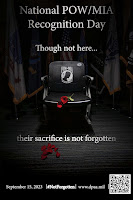- The Clerk of the House Veterans Affairs Committee admitted that it was an oversight not to post the ADBC-MS testimony on the hearing website repository page. It appear the House committee did not change its posting policy. The clerk for the
apparently neglected to share the testimony with his counterpart at the House committee. You can find the testimony
Why the Senate Veterans Affairs Committee would block our testimony in this passive aggressive manner we do know. Soon after the hearing, the Committee staff took another unusual position, that of objecting to and blocking a proposed gold medal bill for the men and women who fought in the early defensive battles of WWII in the Pacific. They were vague as to why other than they had problems with the "findings" or statements of fact and noted that they cannot block a bill. But the reality is that their objections did stop the bill from being introduced. The "findings" were written by a committee of world class, American historians of the Pacific War.
I guess the Senate Veterans Affairs Committee got tired of the ADBC-MS asking for the same things every year. Or maybe they did not again want to hear that there are veterans they were leaving behind and forgetting. Or maybe it is too unbelievable that Japan was once our enemy and considered more brutal than the Nazis. Or maybe Japan's history disinformation campaigns, which are now being directed at POWs, are successful.
AMERICAN DEFENDERS OF THE PACIFIC
THE YEAR FOR A CONGRESSIONAL GOLD MEDAL
Chairmen Tester and Bost, Ranking Members Moran and Takano, and Members of the Senate and House Veterans Affairs Committees, thank you for allowing us to describe how Congress can meet the concerns of veterans of World War II in the Pacific.
The American Defenders of Bataan and Corregidor (ADBC) was founded in January 1946 at the Fort Devens, Massachusetts hospital by former POWs of Imperial Japan. The ADBC represented the men and women of the U.S. Armed Forces in the Pacific who participated in the early resistance to, and defensive battles against, the armed forces of Imperial Japan from December 8, 1941, to June 9, 1942. Nearly all the survivors endured nearly four years of merciless imprisonment by Imperial Japan.
Our subsequent Memorial Society now represents their families and descendants, as well as scholars, researchers, and archivists. Our goal is to preserve the history of the American POW experience in the Pacific and to teach future generations of the POWs’ sacrifice, courage, determination, and faith—the essence of the American spirit.
Background
Eighty-one years ago today marks the fall of the Dutch East Indies (today’s Indonesia) to Japan and the capture on Java of a West Texas National Guard Battalion as well as two American aviators and one sailor too seriously wounded to be moved. Barely a week before, the heavy cruiser USS Houston (CA-30) went down in the Battle of Sunda Strait marking the decimation of the United States Asiatic Fleet that had commanded the United States Navy and Marines in the region since 1902. American forces on Wake Island and Guam had surrendered in December 1941.
In April, after 99 days of constant warfare and no hope of resupply, the Bataan Peninsula in the Philippines was surrendered and the infamous Bataan Death March began. Less than one month later, on May 6th, the Fortress Island of Corregidor and its associated commands defending Manila were surrendered. The rest of American and Filipino units throughout the Philippines were surrendered on June 9th. And on June 7th, Japan invaded Alaska’s Kiska and Attu islands in the Aleutians, imprisoning 42 Native Americans, 8 Navy weathermen, one female school teacher, and killing three men.
I testify today to encourage your efforts to remember these American men and women who gave their all under desperate conditions to demonstrate determination and resourcefulness against a ruthless enemy and a long-decided U.S. and British policy of prioritizing the war in Europe. The result was that most of these soldiers became POWs of Japan who suffered some of the War’s worst consequences. One-third did not return home.
For all, the homefront was their third battle--after surviving warfare in the Pacific and enduring atrocities as a POW. Forced to sign gag orders about the horrors they witnessed and unable to explain the after-effects of torture, abuse, starvation, and trauma, the POWs of Japan first focused, as do today’s veterans, on obtaining healthcare, disability benefits, survivor benefits, caregiver support, mental health access, and education.
The fourth and final battle for the American POWs of Japan is for them not to be forgotten: both by their country and the Japanese. Current and future generations can be inspired by their “victory from within.” As President Franklin D. Roosevelt said in August 1943, when the outcome of WWII was still uncertain, “The story of the fighting on Bataan and Corregidor—and, indeed, everywhere in the Philippines–will be remembered so long as men continue to respect bravery, and devotion, and determination.”
Our asksTo ensure that the sacrifices and unique history of our fighting men and women in the Pacific during 1941 and 1942 are not forgotten I ask Congress to:
1. Award, collectively to the American defenders of Bataan and Corregidor, as defined in U.S. Senator Martin Heinrich’s and Representative Teresa Leger Fernandez’s forthcoming Congressional Gold Medal bill. This group represents every U.S. state, territory, tribe, and military service. It is the most diverse World War II Congressional Gold Medal cohort.
2. Ask the Government of Japan, to create a central government-funded memorial in Japan, as none exist, for the Allied POWs of WWII at the Port of Moji on Kyushu, Japan where most of the “hellships”–floating dungeons where POWs were denied air, space, light, sanitation, and food–first arrived in Japan to unload their sick and dying human cargo. This memorial should be selected from a world competition. Currently, the only monuments at Moji are to Japanese war horses, Japanese soldiers, and bananas.
3. Instruct the U.S. Department of State to prepare a report for Congress on the history and funding of the “Japan/POW Friendship Program.” This visitation program began in 2010. The report should include (i) how other Allied POW reconciliation programs initiated by the Government of Japan in 1995 compare both in funding and programming and (ii) how the U.S. program compares with other “Kakehashi” people exchange programs in the United States funded by the Government of Japan starting in 2015.
4. Ask the Government of Japan to continue and institutionalize the “Japan/POW Friendship Program” established in 2010. Initially established as a reconciliation visit to Japan for former POWs modeled after ones established in 1995 for British, Dutch, and Australian POWs, the program has included widows and the elderly children of POWs. The program needs to transform into a permanent educational, remembrance, and exchange initiative encompassing history, justice, and democracy. It needs to be permanent, not merely a yearly, diplomatic “deliverable” subject to Japan’s budget whims.
Thus far, there have been 12 trips, one each in the fall of 2010 through 2019. In 2015, there were two trips. In 2016, 2018, and 2019, due to the advanced age of surviving POWs, only widows and children participated in the program. No trips were held in 2020, 2021, or 2022. A four-day trip for 7 children of POWs was held in February this year. In all, 46 former POWs, all in their late 80s or 90s, as well as nine widows and 25 children in their 60s and 70s have made the trip to Japan. A number of the caregiver companions were wives, children, and grandchildren.
5. Ask the Government of Japan to publish in Japanese, English and other languages on the website of the Foreign Ministry of Japan the 2009 Cabinet Decision offering a formal apology to all the prisoners of war of Japan and the text of Ambassador Ichiro Fujisaki’s May 30, 2009 speech to the convention of the ADBC offering an apology to the POWs:
I would like to convey to you the position of the government of Japan on this issue. As former Prime Ministers of Japan have repeatedly stated, the Japanese people should bear in mind that we must look into the past and to learn from the lessons of history. We extend a heartfelt apology for our country having caused tremendous damage and suffering to many people, including prisoners of wars, those who have undergone tragic experiences in the Bataan Peninsula, Corregidor Island, in the Philippines, and other places.
6. Ask the Government of Japan to honor its 2015 written promise to include the “full history” of Japan’s UNESCO World Industrial Heritage properties of the Meiji Industrial Revolution: Iron and Steel, Shipbuilding and Coal Mining. The history of POW slave labor at many of the Heritage sites is not included at those locations or at the Tokyo Information Center.
7. Amend title 36, United States Code to include National Former POW Recognition Day among the days the POW/MIA flag is required to be displayed. This is April 9th, which is the anniversary of the Bataan Death March. The President is already required to issue a proclamation for this remembrance day.
High price of freedomBy June 1942, most of the estimated 27,000 Americans ultimately held as military POWs of Imperial Japan had been surrendered–they did not surrender. By the War’s end, roughly one-third or more than 12,000 Americans had died in squalid POW camps, in the fetid holds of “hellships,” or in slave labor camps owned by Japanese companies. Almost one-third (or 4,000) died from friendly fire in unmarked hellships sunk by American planes and submarines.
Surviving as a POW of Japan and returning home was the beginning of new battles: finding acceptance in society and living with serious mental and physical ailments. In the first six years after the war, deaths of American POWs of Japan were more than twice those of the comparably aged white male population. These deaths were disproportionately due to tuberculosis, suicides, accidents, and cirrhosis. In contrast, 1.5 percent of Americans in Nazi POW camps died (the mortality rate for POWs of Japan was 20 times greater). In the first six years after liberation, the mortality rate of those who survived the Japanese POW camps was three times the rate of the Nazi POW camp survivors.
Eighty-two years after the start of the War in the Pacific, it is time to recognize the Americans who fought the impossible and endured the unimaginable in the war against tyranny in the Asia. The American men and women in the early months of the war in the Pacific fought with limited and outdated weapons and no hope of reinforcement or resupply.
In return for their sacrifices and service, they ask that their government keep its moral obligation to them. They do not want their history ignored or exploited. What they want most is to have their government stand by them to ensure they will be remembered, that our allies respect them, and that their American history is preserved accurately for future generations.
Ms. Jan Thompson
President, American Defenders of Bataan & Corregidor Memorial Society
Daughter of PhM2c Robert E. Thompson USN, USS Canopus (AS-9)
Survivor of the hellships Oryoku Maru, Enoura Maru, and the Brazil Maru
Survivor of the POW Camps Bilibid (Philippines), Fukuoka 3B (Japan), & Mukden (China)
https://www.adbcmemorialsociety.org/




